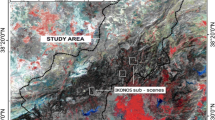Abstract
A process-based model, Wetland-DNDC, was modified to enhance its capacity to predict the impacts of management practices on carbon sequestration in and trace gas emissions from forested wetland ecosystems. The modifications included parameterization of management practices (e.g., forest harvest, chopping, burning, water management, fertilization, and tree planting), inclusion of detailed anaerobic biogeochemical processes for wetland soils, and utilization of hydrological models for quantifying water table variations. A 150-year management scenario consisting of three stages of wetland forest, deforestation/drainage, and wetland restoration was simulated with the Wetland-DNDC for two wetlands in Minnesota and Florida, USA. The impacts of the management scenario on carbon ecosystem exchange, methane emission, and nitrous oxide emission were quantified and assessed. The results suggested that: (1) the same management scenario produced very different consequences on global warming due to the contrast climate conditions; and (2) methane and nitrous oxide fluxes played nonnegligible roles in mitigation in comparison with carbon sequestration.







Similar content being viewed by others
References
I. C. Anderson J. S. Levine (1986) ArticleTitleRelative rates of nitric oxide and nitrous oxide production by nitrifiers, denitrifiers, and nitrate respirers. Applied and Environmental Microbiology 51 938–945 Occurrence Handle1:CAS:528:DyaL28XktVeht7w%3D
F. G. Bader (1978) ArticleTitleAnalysis of double-substrate limited growth. Biotechnology and Bioengineering 20 183–202 Occurrence Handle1:CAS:528:DyaE1cXhsFSmtbg%3D Occurrence Handle630068
R. Birdsey L. S. Heath (2001) Forest inventory data, models, and assumptions for monitoring carbon flux. R. Lal (Eds) Soil carbon sequestration and the greenhouse effect Soil Science Society of America Madison, WI 137–154
A. Bollmann R. Conrad (1998) ArticleTitleInfluence of O2 availability on NO and N2O release by nitrification and denitrification in soils. Global Change Biology 4 387–396 Occurrence Handle10.1046/j.1365-2486.1998.00161.x
E. A. Holland D. S. Schimel (1994) ArticleTitleEcosystem and physiological controls over methane production in northern wetlands. Journal of Geophysical Research 99 1563–1571 Occurrence Handle10.1029/93JD00391
IPCC (Intergovernmental Panel on Climate Change). 1997. Guidelines for national greenhouse gas inventories. OECD/ODCE, Paris
Koussis, A. D., M. Sophocleous, L. Bian, and S. Zou. 1994. Lower Republican River basin: stream–aquifer study. Technical Report. University of Kansas
C. Li (2000) ArticleTitleModeling trace gas emissions from agricultural ecosystems. Nutrient Cycling in Agroecosystems 58 259–276 Occurrence Handle10.1023/A:1009859006242 Occurrence Handle1:CAS:528:DC%2BD3MXhtVeisbo%3D
C. Li S. Frolking T. A. Frolking (1992) ArticleTitleA model of nitrous oxide evolution from soil driven by rainfall events: 1. Model structure and sensitivity. Journal of Geophysical Research 97 9759–9776 Occurrence Handle1:CAS:528:DyaK3sXkt1GktQ%3D%3D
C. Li J. Aber F. Stange K. Butterbach-Bahl H. Papen (2000) ArticleTitleA process-oriented model of N2O and NO emissions from forest soils: 1, Model development. Journal of Geophysical Research 105 4369–4384 Occurrence Handle10.1029/1999JD900949 Occurrence Handle1:CAS:528:DC%2BD3cXhvFektbw%3D
K. Minkkinen J. Laine (1998) ArticleTitleLong-term effect of forest drainage on the peat carbon stores of pine mires in Finland. Canadian Journal of Forest Research 28 1267–1275 Occurrence Handle10.1139/cjfr-28-9-1267
Neitschm, S. L., J. G. Arnold, J. R. Kiniry, J. R. Williams, and K. W. King. 2002. Soil and water assessment tool theoretical documentation, version 2000. TWRI Report TR-191. Texas Water Resources Institute, College Station, Temple, Texas
E. A. Paul F. E. Clark (1989) Soil microbiology and biochemistry, 2nd ed. Academic Press San Diego 166 pp
R. L. Sass F. M. Fisher F. T. Turner M. F. Jund (1991) ArticleTitleMethane emission from rice fields as influenced by solar radiation, temperature, and straw incorporation. Global Biogeochemical Cycles 5 335–350 Occurrence Handle1:CAS:528:DyaK38XhtFanu7s%3D
Srinivasan, R., Arnold, J., Rosenthal, W., and Muttiah, R. S. 1993. Hydrologic modeling of Texas Gulf Basin using GIS. Proceedings, second international conference on integrating GIS and environmental modeling, Breckenridge, Colorado
F. Stange K. Butterbach-Bahl H. Papen S. Zechmeister-Boltenstern C. Li J. Aber (2000) ArticleTitleA process-oriented model of N2O and NO emission from forest soils: 2, Sensitivity analysis and validation. Journal of Geophysical Research 105 4385–4398 Occurrence Handle10.1029/1999JD900948 Occurrence Handle1:CAS:528:DC%2BD3cXhvFektb0%3D
W. Stumm J. J. Morgan (1981) Aquatic chemistry: an introduction emphasizing chemical equilibria in natural waters, 2nd ed. John Wiley & Sons New York 418–503
G. Sun H. Riekerk N. B. Comerford (1998) ArticleTitleModeling the hydrologic impacts of forest harvesting on Florida flatwoods. Journal of the American Water Resources Association 34 843–854
R. E. Terry R. L. III Tate J. M. Duxbury (1981) ArticleTitleNitrous oxide emissions from drained, cultivated organic soils of South Florida. Journal of the Air Pollution Control Association 31 1173–1176 Occurrence Handle1:CAS:528:DyaL38XhtFSjug%3D%3D
C. C. Trettin M. F. Jurgensen (2003 (in press)) Carbon cycling in wetland forest soils. J. Kimble R. Birdsie R. Lal (Eds) Carbon sequestration in US forests. Lewis Publishers Boca Raton, Florida
Trettin, C. C., B. Song, M. F. Jurgensen, and Li, C. 2001. Existing soil carbon models do not apply to forested wetlands. GTR SRS-46. USDA Forest Service, Washington, DC
R. Wassmann M. X. Wang X. J. Shangguan X. L. Xie R. X. Shen Y. S. Wang H. Papen H. Rennenberg W. Seiler (1993) ArticleTitleFirst records of a field experiment on fertilizer effects on methane emission from rice fields in Hunan-province (PR China). Geophysics Research Letters 20 2071–2074
K. Yagi K. Manami (1990) ArticleTitleEffect of organic matter application on methane emission from some Japanese paddy fields. Soil Science and Plant Nutrition 36 599–610 Occurrence Handle1:CAS:528:DyaK3MXksVyhsb0%3D
Zhang, Y., Li, C. Trettin, C. C. Li, H., and Sun, G. 2002. An integrated model of soil, hydrology and vegetation for carbon dynamics in wetland ecosystems, Global Biogeochemical Cycles.
Acknowledgments
This study is supported by the Southern Global Change Program, USDA Forest Service, and NASA’s Terrestrial Ecosystems and Global Change Program.
Author information
Authors and Affiliations
Rights and permissions
About this article
Cite this article
Li, C., Cui, J., Sun, G. et al. Modeling Impacts of Management on Carbon Sequestration and Trace Gas Emissions in Forested Wetland Ecosystems . Environmental Management 33 (Suppl 1), S176–S186 (2004). https://doi.org/10.1007/s00267-003-9128-z
Published:
Issue Date:
DOI: https://doi.org/10.1007/s00267-003-9128-z




